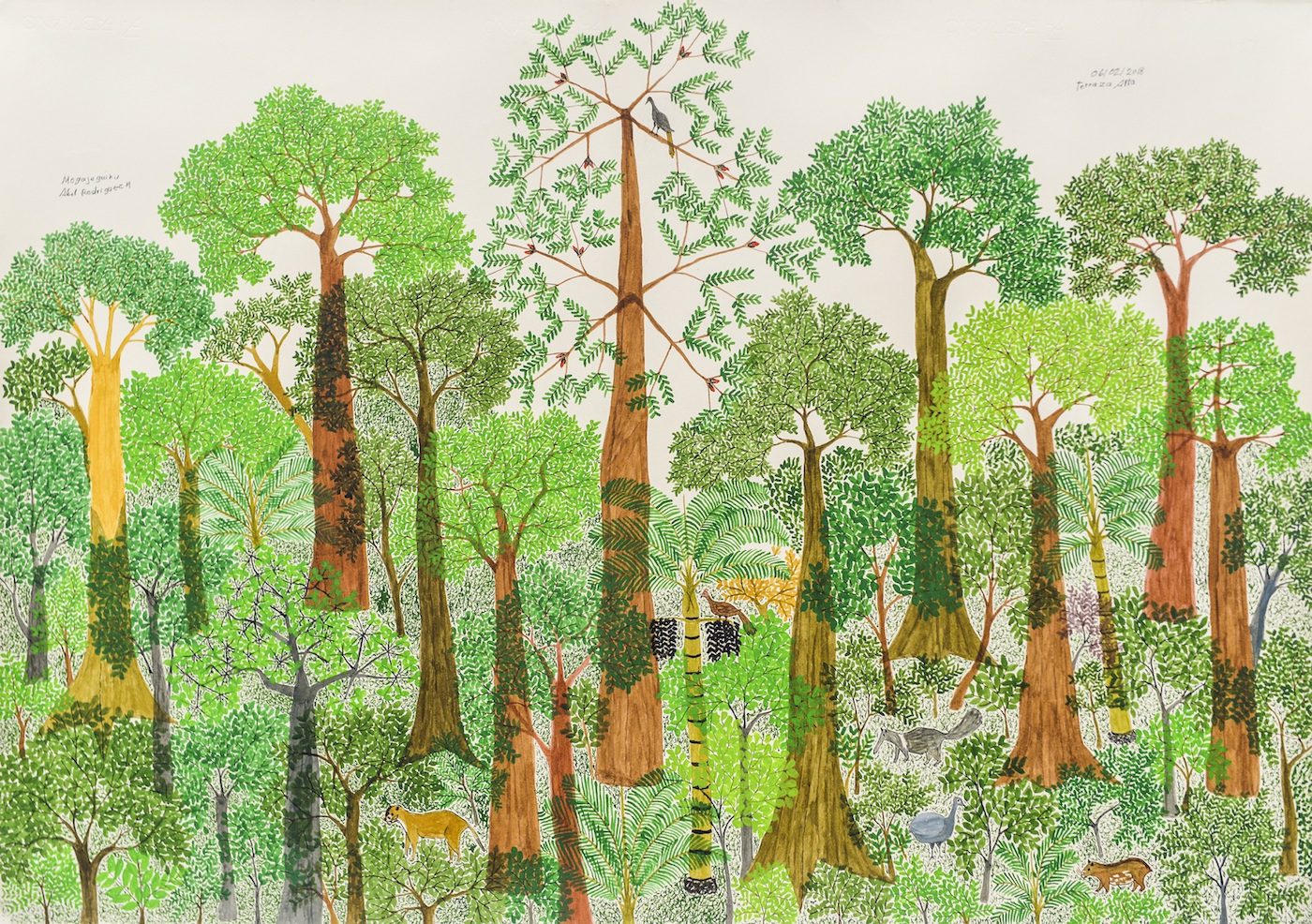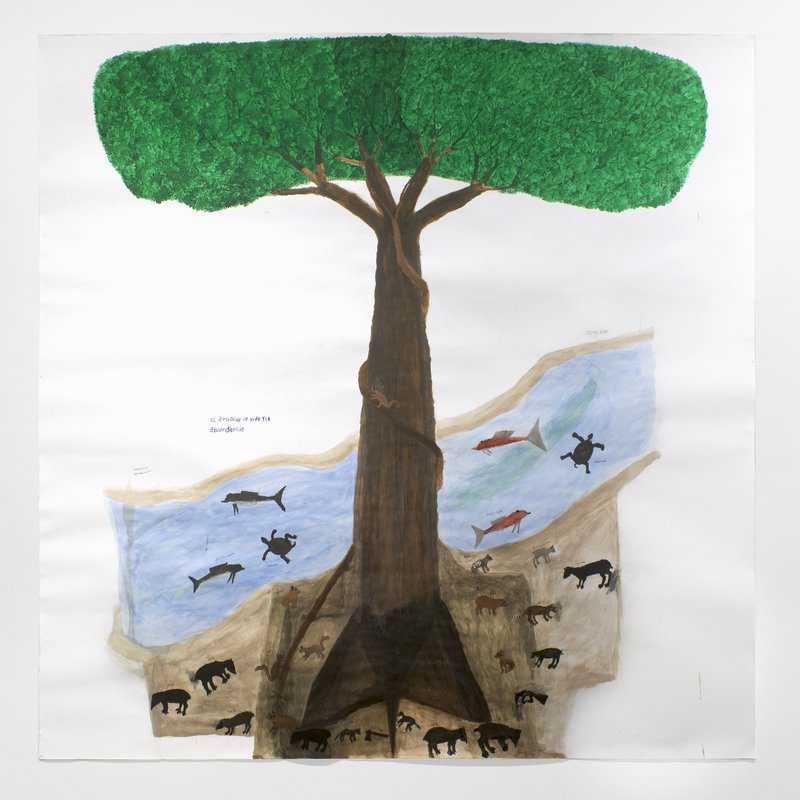The Colombian artist of Nonuya origin is known in the art world by using drawing to preserve the memory of Amazonian flora at risk of extinction.

Abel Rodríguez, Terraza Alta II, 2018. Courtesy of the artist and Instituto de Visión.
Trained since childhood by a family member to be a “namer of plants,” Abel Rodríguez uses his works as a way of translating subjectivities of the Amazonian ecosystem. His illustrations show the life processes of the forest and, at the same time, the processes of its death. We can tell the story of the practice of Abel Rodríguez, an Indigenous Nonuya artist born in the Colombian Amazon who has been gaining notoriety on the international contemporary art circuit, in contrasting ways. On the one hand, his drawings are a valuable resource for botanical studies of flora undergoing decimation for decades. His illustrations show detailed processes of change in forest life after flooding (as in Ciclo annual del bosque de la vega [The Annual Cycle of La Vega Forest], 2009–10) and myths about the origin of the world (as in Árbol de la vida y de la abundancia [Tree of Life and Abundance], 2012). The flora is often portrayed in contact with the local fauna, indicating the food of the region’s animals. Abel Rodríguez, El arbol de la vida y la abundancia, 2022, Ink on paper / Tinta sobre papel, 591⁄2 x 59 in., 151 x 150 cm. Courtesy of the artist and Instituto de Visión. On the other hand it is possible to speak of Rodríguez’s drawings from an artistic perspective, and this has very much been happening. Especially after his participation in documenta 14, in 2017, his work has gained a strong presence at art exhibitions. He also participated in the 34th São Paulo Biennial in 2001 and in the 23rd Sydney Biennial in 2022. And Rodríguez is represented by the Instituto de Visión Gallery, one of the most important in Colombia. What connects these two stories began in the 1980s at a meeting between Mogaje Guihu, Abel’s original name, and Carlos Rodríguez, a biologist who heads the Colombian branch of the Dutch NGO Trobenpos, which was looking for local guides to identify plants of Amazonian botany. According to the 34th São Paulo Biennial presentation text, Abel Rodríguez, trained since his childhood by an uncle to be a “namer of plants” and “a repository of the community’s knowledge about the various botanical species in the forest, their practical uses and their ritual importance,” was recommended as the ideal person. Thus began a relationship that would also determine his insertion into the art universe. Carlos, whose last name Rodríguez adopted when he chose his Western name, encouraged him to draw to keep his memories alive. This encouragement increased after a traumatic diasporic process: in the 1990s, Rodríguez had to leave his native region to flee the armed conflict that had taken hold of the country and was devastating the region’s natural resources. Since then Rodríguez has been living with family in a peripheral region of Bogota, although he still maintains contact with the forest. It is difficult to find equivalent works by others that at once accurately convey information about a given ecosystem and bring awareness to a broader audience through their artistic value. Even in well-known examples in the West which combine scientific value with literary writing, the big difference from Rodríguez’s work is that they are clearly approaches from a white perspective. Especially in botany, a science that was born with a connection to colonial imaginary, an important debate has begun recently about scientific or popular classifications and nomenclatures of species from the plant kingdom that are laden with racial, patriarchal, or religious prejudices (“wandering Jew,” “Adam’s rib,” and “shameless Maria” are a few of the popular examples). This debate was the basis for the Botannica Tirannica (Tyrannical Botany) exhibition, for example, held last year by artist and researcher Giselle Beiguelman at the Jewish Museum in São Paulo. Using images made with artificial intelligence, she created new possibilities for combinations that question the standards of nomenclature, generating, in her words, a kind of “ecosystem of a wandering science, where hybrid beings flourish.” It is in this sense that Abel Rodríguez’s role as “namer of plants” gains symbolic importance: he reclaime a role that was taken away from Indigenous peoples. At the same time, the very idea of a grand purpose is something that goes beyond his worldview. In a documentary directed by Fernando Arias in 2014, shown at an exhibition at the BALTIC Centre for Contemporary Art in the UK in 2020, the Indigenous artist gave the best response when asked about what his drawings mean to him: “Well, nothing. I only show a simple image.” Similarly, writer and activist Ailton Krenak reformulates the best-known Biblical phrase about the origin of the world in his most recent book, Futuro Ancestral (Ancestral Future, 2022), by stating: “In reverse, we could say that in the beginning there was the leaf. Other narratives will say that in the beginning there was the word.” If the plant kingdom has its own vocabulary, we should say that Abel Rodríguez is merely a translator of what plants mean. And often they may not mean anything.

Abel Rodríguez is an elder visual artist of the Nonuya people and a deep connoisseur of plants and ecological systems of the Amazon Basin. He was born in 1944 in Cahuinarí, in the Colombian Amazon, and has been living in Bogotá since the 2000s.
Nathalia Lavigne is a researcher, curator, and writer about contemporary art and culture. She lives between São Paulo, Rio de Janeiro, and Berlin.
Translation: Sara Hanaburgh
This article is from the latest C& and C&AL Print Issue “Ecologies”. Read the full magazine here.
ECOLOGIES
More Editorial